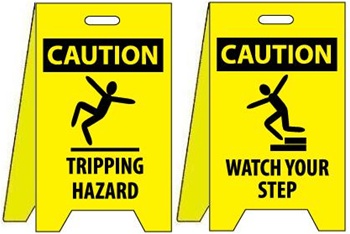List 4 hazards for each of the following;
In the physical environment:
Crowds
Electrical wiring
Pests
Flooring
Plant:
Appliances
Machinery
Tools and Equipment
Trees

Working Practices:
Roster/shifts
Open/Closing Procedures
Length of Tasks
How workers go about tasks. Are they following regulations?
Security Issues: Customer behaviour
Storage of important documents, keys and cash.
Theft and robbery
Terrorism
Security cameras and guards on patrol.

Explain 2 ways in how these hazards are can be identified.
A hazard can firstly be identified by having safety posters around the workplace because employees will see what to do and not to do. Another way to identify hazards is by nominating someone to be the WHS representative who can check out any equipment and ensure all employees follow regulations.
Provide 4 measures or controls to eliminate any of the above mentioned hazards.
- Isolating the hazard
- Introducing engineering controls
- Substitute the equipment for tools that are more safe
- Adopting Administration controls
Use appropriate methods and documents for hazard identification, risk assessment and control.
List 2 hazard identification and risk assessment tools you would use in your specific workplace.
1. Checklists
2. Guidance documents or handbook
List 6 appropriate methods you would use in your workplace to identify hazards and risks for your specific workplace (Hospitality, Tourism or Events).
1. Conduct site safety audits
2. Observation of daily activities
3. Incident reports
4. Investigate accidents
5. Safety Checklist
6. Holding meetings to discuss any changes or developments.
Provide evidence of the common methods to assess safety risks including the four staged process model recommended and published by the state and territory work health and safety authorities.

- Identify/review injuries or illness
- Discuss consequences that could be a result from the hazard
- Determine the overall risk level
E.g. Safety Checklist

Daily Observation:

Examples:
- Updating work systems or equipment
- Take action as soon as possible before the risk increases.
- Maintain a job rotation
- Provide proper PPE for workers:

- Routine maintenance
Demonstrate knowledge of the basic aspects of OHS or WHS legislation for identifying hazards, assessing and controlling risks.
Explain the relevant state or territory OHS or WHS legislation in relation to the following:
-When, where and how hazards must be identified
Managing risk is an on-going process that can be changed every time something may need to be updated within the workplace. While hazards are usually identified by finding things or situations that can potentially be a risk.
- When, where and how risk assessments must be conducted
The risk assessment must take part within the business itself by a competent persons. Risk assessments are done regularly to identify any potential hazards in the future and determing the liklihood of it happening. This is usually done through filling out paper work and writing up a table to evaluate different scenarios and consult with others.
- The Consultation Process
The consultation process is needed when making decisions about risk assessment and to identify hazards. It's important that during the consultation, employees should be to provide advice, express views and raise any issues. This process should be fair and reasonable for individuals and corporate bodies.
- Committees
The person conducting a business or undertaking at a workplace must establish a health and safety committee for the business or undertaking or part of the business (WHS Act 2011). If a committee meeting is requested it must be done before 2 months is up and there should at least 5 people participating. As part of having a committee, one person should be nominated as the WHS representative.
- Record Keeping
It's important that any business keep records, this may include: copies of safe methods and risk assessments. These documents must accessible for all workers and must be kept for at least 2 years after any incident for future reference including inspections. There are penalties if documents are not kept safe and deleted/thrown away. Log books are also kept on site at business for amusement devices to keep track of any users and maintenance.
Sources:
http://www.legislation.nsw.gov.au/maintop/view/inforce/act+10+2011+cd+0+N
http://www.australianbusiness.com.au/whs/resources/managing-ohs-risk-in-your-workplace (accessed on 8 Sept 2014)





